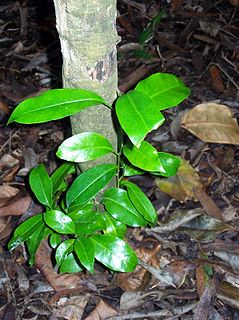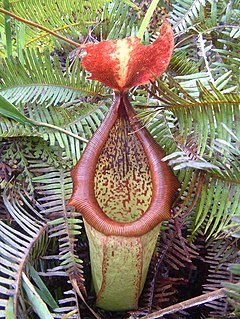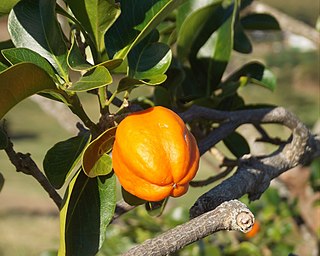
Alstonia is a widespread genus of evergreen trees and shrubs, of the family Apocynaceae. It was named by Robert Brown in 1811, after Charles Alston (1685–1760), professor of botany at Edinburgh from 1716-1760.

Aleurites is a small genus of arborescent flowering plants in the Euphorbiaceae, first described as a genus in 1776. It is native to China, the Indian Subcontinent, Southeast Asia, Papuasia, and Queensland. It is also reportedly naturalized on various islands as well as scattered locations in Africa, South America, and Florida.

Lawsonia inermis, also known as hina, the henna tree, the mignonette tree, and the Egyptian privet, is a flowering plant and the sole species of the genus Lawsonia. It is the source of the dye henna used to dye skin, hair and fingernails, as well as fabrics including silk, wool and leather. Medicinal properties for the cure of renal lithiases, jaundice, wound healing; prevent skin inflammation. The bark is traditionally used in treatment of jaundice and enlargement of the spleen, renal calculus, leprosy and obstinate skin diseases. The species is named after the Scottish physician Isaac Lawson, a good friend of Linnaeus.

Fontainea is a genus constituting part of the plant family Euphorbiaceae. The nine currently known species grow naturally in Queensland (Qld) and New South Wales (NSW) Australia, New Caledonia and Vanuatu, and Papua New Guinea. Some species are commonly named blushwood.
Androstachys johnsonii, the Lebombo ironwood, is a medium-sized Afrotropical tree species, and the sole member of the genus Androstachys in the Picrodendraceae. It is slow-growing, evergreen to deciduous, and dioecious, with flowers that are wind-pollinated. It is native to southeastern Africa and Madagascar, where it generally occurs gregariously on rocky hillsides, particularly in hot and dry situations. It produces a hard, durable wood which is of economic interest. Its specific name commemorates W. H. Johnson, a 19th-century Director of Agriculture in Mozambique. Four related species which are native to Madagascar, are usually placed in genus Stachyandra.

Nepenthes lamii is a tropical pitcher plant endemic to New Guinea, where it grows at an altitude of up to 3520 m above sea level, higher than any other Nepenthes species. Although once confused with N. vieillardii and previously regarded as conspecific with the closely related N. monticola, it is now recognised as a distinct species.

Nepenthes insignis is a tropical pitcher plant endemic to New Guinea and surrounding islands. The specific epithet insignis is Latin for "distinguished" or "remarkable".

Stachys byzantina, the lamb's-ear or woolly hedgenettle, is a species of flowering plant in the mint family Lamiaceae, native to Turkey, Armenia, and Iran. It is cultivated over much of the temperate world as an ornamental plant, and is naturalised in some locations as an escapee from gardens. Plants are very often found under the synonym Stachys lanata or Stachys olympica.

Malus coronaria, also known by the names sweet crabapple or garland crab, is a North American species of Malus (crabapple). It grows primarily in the Great Lakes Region and in the Ohio Valley, with outlying populations as far away as Alabama, eastern Kansas, and Long Island.

Alstonia scholaris, commonly called blackboard tree or devil's tree in English, is an evergreen tropical tree in the family Apocynaceae. It is native to southern China, tropical Asia and Australasia.

Cerbera floribunda, commonly known as cassowary plum, grey milkwood, or rubber tree, is a plant in the family Apocynaceae which is native to the region from Sulawesi to the Solomon Islands, including north east Queensland.

Sclerocroton integerrimus, the duiker berry, is a tree in the family Euphorbiaceae, from Southern Africa.
Hevea rigidifolia is a species of rubber tree in the genus Hevea, belonging to the family Euphorbiaceae. It is native to the rainforests of northern Brazil and Colombia, where it is endemic to localities near the upper Rio Negro, a north bank tributary of the Amazon River, and its tributary, the Vaupés River.
Fontainea fugax is a shrub endemic to Queensland, in the family, Euphorbiaceae, growing up to 4 m. In 1997, F. fugax was considered "endangered" having been found in only in the central Burnett district and within an endangered community, threatened by weeds, repeated fires and clearing.
Fontainea subpapuana is a small tree endemic to Papua New Guinea in the family, Euphorbiaceae, which grows to a height of 7 m.

Fontainea pancheri is a small tree or shrub endemic to New Caledonia in the family, Euphorbiaceae, which grows to a height of 15 m.

Bertya opponens, is a shrub/tree in the family Euphorbiaceae, native to Australia and found in New South Wales and Queensland. It is found on ridges amongst mallee in shallow soils. It flowers in July and August.
Phebalium distans, commonly known as the Mt. Berryman phebalium, is a species of small tree that is endemic to south-east Queensland. It is more or less covered with silvery to rust-coloured scales and has warty branchlets, linear leaves and creamy yellow flowers in umbels on the ends of branchlets.
Mallotus floribundus is a tree in the family Euphorbiaceae, in the Stylanthus section, native to Southeast Asia, Wallaceae, New Guinea and the Solomon Islands.
Pimelodendron amboinicum is a tree species in the Euphorbiaceae family. It is found from the Solomon Islands in the southwest Pacific, west to Sulawesi in Indonesia. The timber is used locally, though larger-scale illegal logging is apparent.












